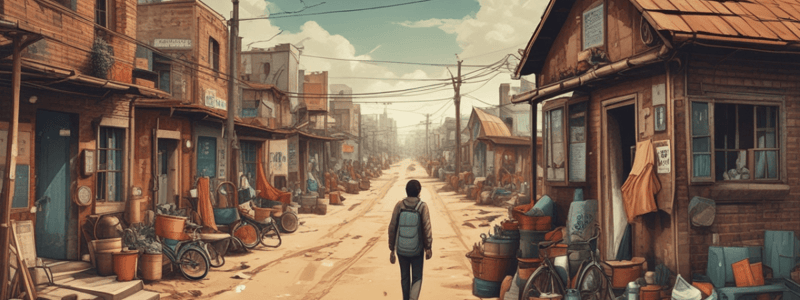Podcast
Questions and Answers
What is the primary difference between absolute poverty and relative poverty?
What is the primary difference between absolute poverty and relative poverty?
- The median income per person in a country
- The amount of money earned per day
- The cost of suitable transport
- The focus on survival versus social exclusion (correct)
What does the median income per person in a country relate to?
What does the median income per person in a country relate to?
- The minimum wage
- The absolute poverty line
- The standard of living in a society
- The relative poverty line (correct)
What is the consequence of earning more than the absolute poverty line but still experiencing poverty?
What is the consequence of earning more than the absolute poverty line but still experiencing poverty?
- One can participate in society fully
- One is considered rich
- One can afford luxuries
- One is still excluded from society (correct)
What does the absolute poverty line tend to be?
What does the absolute poverty line tend to be?
What happens to relative poverty when a country's per person income increases or decreases?
What happens to relative poverty when a country's per person income increases or decreases?
What are the two ways to think about poverty?
What are the two ways to think about poverty?
What does the vertical axis in the graph represent?
What does the vertical axis in the graph represent?
What is the significance of the arbitrary line drawn on the graph?
What is the significance of the arbitrary line drawn on the graph?
What is often used to denote the minimum level of resources needed to survive?
What is often used to denote the minimum level of resources needed to survive?
What is the concept that has an absolute value associated with it?
What is the concept that has an absolute value associated with it?
What is true about the level of absolute poverty?
What is true about the level of absolute poverty?
What is a limitation of using arbitrary income or resource cutoffs to measure absolute poverty?
What is a limitation of using arbitrary income or resource cutoffs to measure absolute poverty?
What is an example of a resource that is necessary for survival?
What is an example of a resource that is necessary for survival?
What is absolute poverty primarily concerned with?
What is absolute poverty primarily concerned with?
What happens to absolute poverty over time if a country's median income level rises?
What happens to absolute poverty over time if a country's median income level rises?
Why is relative poverty used in developed countries like the United States?
Why is relative poverty used in developed countries like the United States?
What is relative poverty primarily concerned with?
What is relative poverty primarily concerned with?
If a country's median income level rises, what happens to the relative poverty line?
If a country's median income level rises, what happens to the relative poverty line?
What is the primary difference between absolute and relative poverty?
What is the primary difference between absolute and relative poverty?
Why is relative poverty important to consider in a society?
Why is relative poverty important to consider in a society?
What is the significance of the median income level in relative poverty?
What is the significance of the median income level in relative poverty?
What happens to relative poverty if a country's income rises, but the rise is not evenly distributed?
What happens to relative poverty if a country's income rises, but the rise is not evenly distributed?
Why does relative poverty consider people whose incomes are too low in their own society?
Why does relative poverty consider people whose incomes are too low in their own society?
Flashcards are hidden until you start studying
Study Notes
Understanding Poverty
- There are two ways to think about poverty: absolute poverty and relative poverty.
Absolute Poverty
- Absolute poverty is a situation where an individual's resources are so low that they threaten their survival.
- This concept has an absolute value associated with it, which is often measured by income (e.g., $1-2 per day).
- The absolute poverty line is an arbitrary cutoff that applies universally, regardless of location (e.g., Africa, Canada, or the Arctic).
- However, this line may not consider real-life variability in resource needs, such as heating expenses in the Arctic.
Characteristics of Absolute Poverty
- Absolute poverty has a fixed threshold that does not change over time, unless redefined.
- As a society becomes richer, the median level of income may rise, leading to a decrease in absolute poverty.
Relative Poverty
- Relative poverty is a concept that measures poverty as a percentage level below the median income of a country.
- This concept is linked to a country's income and is often defined as less than 60% of the median income.
- Relative poverty is concerned with people whose incomes are so low in their own society that they are excluded from society or sidelined.
Key Differences between Absolute and Relative Poverty
- Absolute poverty focuses on survival and basic necessities of life, whereas relative poverty talks about being excluded from society.
- Absolute poverty has a single standard that applies across all countries, whereas relative poverty is related to the society or country where an individual is living.
- Absolute poverty tends to stay the same, whereas relative poverty can track with a country's per person income going up and down.
Studying That Suits You
Use AI to generate personalized quizzes and flashcards to suit your learning preferences.




